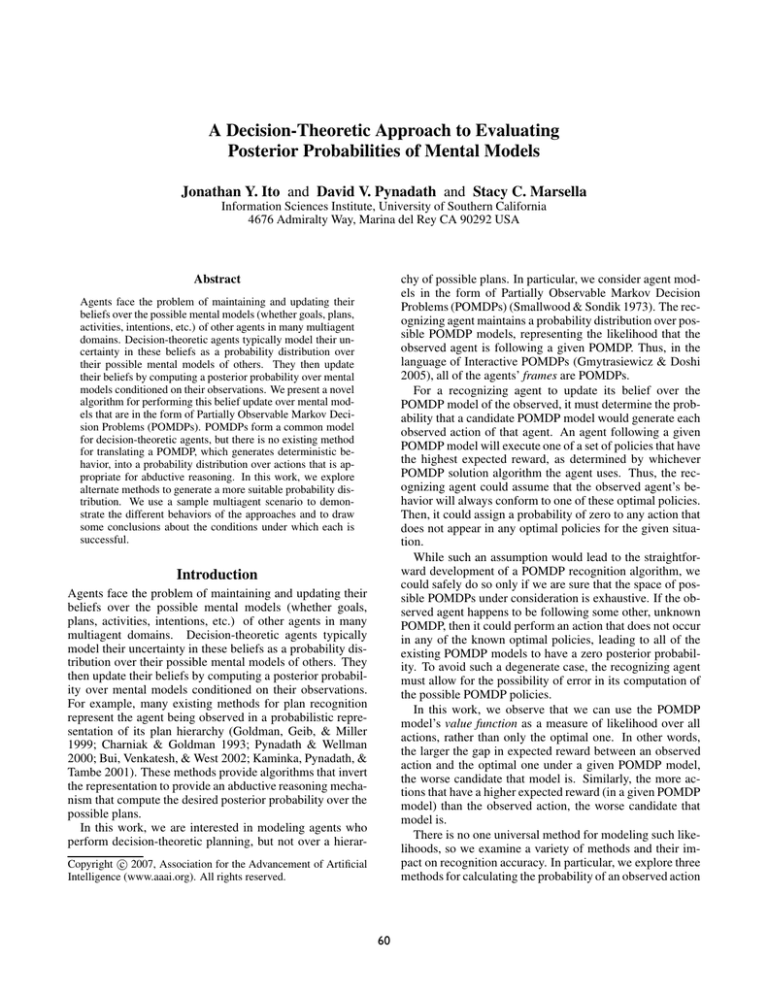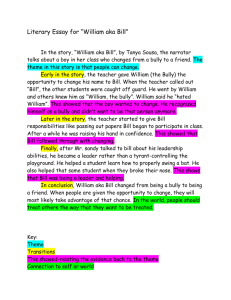
A Decision-Theoretic Approach to Evaluating
Posterior Probabilities of Mental Models
Jonathan Y. Ito and David V. Pynadath and Stacy C. Marsella
Information Sciences Institute, University of Southern California
4676 Admiralty Way, Marina del Rey CA 90292 USA
Abstract
chy of possible plans. In particular, we consider agent models in the form of Partially Observable Markov Decision
Problems (POMDPs) (Smallwood & Sondik 1973). The recognizing agent maintains a probability distribution over possible POMDP models, representing the likelihood that the
observed agent is following a given POMDP. Thus, in the
language of Interactive POMDPs (Gmytrasiewicz & Doshi
2005), all of the agents’ frames are POMDPs.
For a recognizing agent to update its belief over the
POMDP model of the observed, it must determine the probability that a candidate POMDP model would generate each
observed action of that agent. An agent following a given
POMDP model will execute one of a set of policies that have
the highest expected reward, as determined by whichever
POMDP solution algorithm the agent uses. Thus, the recognizing agent could assume that the observed agent’s behavior will always conform to one of these optimal policies.
Then, it could assign a probability of zero to any action that
does not appear in any optimal policies for the given situation.
While such an assumption would lead to the straightforward development of a POMDP recognition algorithm, we
could safely do so only if we are sure that the space of possible POMDPs under consideration is exhaustive. If the observed agent happens to be following some other, unknown
POMDP, then it could perform an action that does not occur
in any of the known optimal policies, leading to all of the
existing POMDP models to have a zero posterior probability. To avoid such a degenerate case, the recognizing agent
must allow for the possibility of error in its computation of
the possible POMDP policies.
In this work, we observe that we can use the POMDP
model’s value function as a measure of likelihood over all
actions, rather than only the optimal one. In other words,
the larger the gap in expected reward between an observed
action and the optimal one under a given POMDP model,
the worse candidate that model is. Similarly, the more actions that have a higher expected reward (in a given POMDP
model) than the observed action, the worse candidate that
model is.
There is no one universal method for modeling such likelihoods, so we examine a variety of methods and their impact on recognition accuracy. In particular, we explore three
methods for calculating the probability of an observed action
Agents face the problem of maintaining and updating their
beliefs over the possible mental models (whether goals, plans,
activities, intentions, etc.) of other agents in many multiagent
domains. Decision-theoretic agents typically model their uncertainty in these beliefs as a probability distribution over
their possible mental models of others. They then update
their beliefs by computing a posterior probability over mental
models conditioned on their observations. We present a novel
algorithm for performing this belief update over mental models that are in the form of Partially Observable Markov Decision Problems (POMDPs). POMDPs form a common model
for decision-theoretic agents, but there is no existing method
for translating a POMDP, which generates deterministic behavior, into a probability distribution over actions that is appropriate for abductive reasoning. In this work, we explore
alternate methods to generate a more suitable probability distribution. We use a sample multiagent scenario to demonstrate the different behaviors of the approaches and to draw
some conclusions about the conditions under which each is
successful.
Introduction
Agents face the problem of maintaining and updating their
beliefs over the possible mental models (whether goals,
plans, activities, intentions, etc.) of other agents in many
multiagent domains. Decision-theoretic agents typically
model their uncertainty in these beliefs as a probability distribution over their possible mental models of others. They
then update their beliefs by computing a posterior probability over mental models conditioned on their observations.
For example, many existing methods for plan recognition
represent the agent being observed in a probabilistic representation of its plan hierarchy (Goldman, Geib, & Miller
1999; Charniak & Goldman 1993; Pynadath & Wellman
2000; Bui, Venkatesh, & West 2002; Kaminka, Pynadath, &
Tambe 2001). These methods provide algorithms that invert
the representation to provide an abductive reasoning mechanism that compute the desired posterior probability over the
possible plans.
In this work, we are interested in modeling agents who
perform decision-theoretic planning, but not over a hierarc 2007, Association for the Advancement of Artificial
Copyright Intelligence (www.aaai.org). All rights reserved.
60
of the bully’s type as a triple of coefficients, with each coefficient in [0, 1] and with the additional constraint that the
three coefficients sum to 1. It is only the relative value of the
coefficients that determines behavior. Thus, to simulate the
behavior of a bully whose aggression is intended to gain the
approval of his peers, we would use an agent with a higher
weight for the second of the reward components. On the
other hand, to simulate a bully of a more sadistic orientation, we would use a higher weight for the third.
The teacher also has three components to her reward function, corresponding to her desire to increase the power of
each of the three students: bully, victim, and onlooker. This
reward function gives the teacher a disincentive for punishing anyone (as the punishee’s power would then decrease)
unless doing so will deter acts of aggression that would reduce the victim’s power even more. A perfectly fair teacher
would give equal weight to the three students’ power. A
bully feeling persecuted by the teacher may be inclined to
think that she favors the victim’s power over his own. On
the other hand, a bully may feel that the teacher shares his
dislike of the victim, in which case he may model here as
having a lower weight for increasing the victim’s power.
We can represent the overall preferences of an agent, as
well as the relative priority among them, as a vector of
→
→
→
weights, −
g , so that the product, −
g ·−
s t , quantifies the degree of satisfaction that the agent receives from the world,
→
as represented by the state vector, −
s t.
conditioned on a particular POMDP model: (1) the ratio of
expected rewards, (2) a linear ranking method, and (3) an
exponential ranking method. We explore and evaluate these
different methods in a sample domain within the PsychSim
(Marsella, Pynadath, & Read 2005; Pynadath & Marsella
2005) multiagent framework.
PsychSim Simulation Framework
PsychSim is a multiagent framework for running social simulations. It operationalizes existing psychological theories
as boundedly rational computations to generate more plausibly human behavior. A central aspect of the PsychSim
design is that agents have fully qualified decision-theoretic
models of others. Such quantitative recursive models give
PsychSim a powerful mechanism to model a range of factors
in a principled way. Each agent within PsychSim maintains
independent beliefs about the world, has its own goals and
its own policies for achieving those goals. The PsychSim
framework is an extension to the Com-MTDP model (Pynadath & Tambe 2002) of agent teamwork.
Example Domain
We have taken our example domain from a scenario in
childhood aggression modeled within PsychSim. There are
agents for three students: a bully, his victim (i.e., the student he focuses his aggression on), and an onlooking student to whom the bully looks for affirmation. There is also a
teacher who wishes to prevent any incidents of aggression.
The teacher can deter the bully from picking on his victim
by doling out punishment. We focus on the problem facing
the bully agent, whose decision on whether or not to pick on
his victim must consider the possible punishment policy of
the teacher.
Actions
The teacher has 7 options in her action set, At . She can
do nothing; she can scold the bully, onlooker, or the entire
class; or she can punish the bully, onlooker, or the entire
class. Punishing a student causes a more sever decrease in
a student’s power than simply scolding. The onlooking student has 2 option in his action set, Ao : laugh at the victim,
or do nothing. The bully has 2 actions in his action set, Ab :
pick on the victim or do nothing.
The state of the world changes in response to the actions
performed by the agents. We model these dynamics
using
→
→
→
a transition probability function, T −
s ,−
a ,−
s ′ , to capture
the possibly uncertain effects of these actions on the subsequent state:
→
→
→
→
−
→
→
−
→
P −
s t+1 = −
s ′ |−
st=−
s ,→
at =−
a =T −
s ,→
a ,−
s ′ (1)
State
Each agent model includes features representing its “true”
state. This state consists of objective facts about the world,
some of which may be hidden from the agent itself. For our
example bully domain, each agent has a power state feature
representing the strength of the agent. Thus powerbully represents the power of the bully agent. We represent the state
→
as a vector, −
s t , where each component corresponds to one
of these state features and has a value in the range [−1, 1].
For example, the bully’s attack on the victim impacts the
power of the bully, the power of the victim, etc. The distribution over the bully’s and victim’s changes in power is
a function of the relative powers of the two - e.g., the larger
the power gap that the bully enjoys over the victim, the more
likely the victim is to suffer a big loss in power.
Reward
PsychSim uses a decision-theoretic model of preferences, so
the bully agent decides whether or not to pick on his victim through a finite-horizon evaluation of expected reward.
There are three components of the bully’s reward function:
(1) a desire to increase his power, which decreases when he
is punished; (2) a desire for affirmation from the onlooking
student, which increases when the onlooker laughs along as
the bully picks on the victim; and (3) a desire to decrease
the victim’s power, which decreases when the bully picks
on him (as well as when the onlooker laughs at him). We
define the reward function as a linear combination of these
three components, so that we can reduce the specification
Policies
The policy of the teacher depends on not only her mental
models of the students, but also on the prior actions of the
students. In other words, the teacher may perform a different
action when the bully picks on the victim than when he does
not. Thus, the policy, πT : MT B × MT O × AB × AO →
AT . Over the infinite space of possible reward functions for
61
the teacher in this classroom scenario, there are only eight
policies that are ever optimal. However, there are 74 = 2401
possible policies in the overall space, so a bully considering
only optimal policies is ignoring a large set of possibilities.
We model each agent’s real policy table as including a
bounded lookahead policy rule that seeks to best achieve the
agent’s goals given its beliefs. To do so, the policy considers
all of the possible actions/messages it has to choose from
and measures the results by simulating the behavior of the
other agents and the dynamics of the world in response to the
selected
t action/message. They compute a quantitative value,
→
−
→t
−
Va b , of each possible action, a, given their beliefs, b .
Va
V
−t
→
b
=
t+1 →
−
b
=
EV
0.65
0.49
0.73
0.65
0.83
randomly, with the probability of a given action being proportional to its expected reward. More precisely we assign a
probability that an agent will perform a given action as equal
to the ratio of the expected reward of that particular action
to the total summation of expected rewards of all actions the
agent can perform at any given time step.
t t −
→
→
−
−
→
g · T b , a + V T b , a (2)
N
X
→t+τ
−
−
→
g · b
(3)
E (aj )
Pevr (aj |mi ) = P
j E (aj )
τ =1
Thus, an agent first uses the transition function, T , to
project the immediate effect of the action, a, and then
projects another N steps into the future, weighing each state
→
along the path against its goals, −
g . Thus, the agent is seeking to maximize the expected value of its behavior, along
the lines of decision policies in decision theory. However,
PsychSim’s agents are only boundedly rational, given that
they are constrained, both by the finite horizon, N , of their
→
−
lookahead and the possible error in their belief state, b .
(5)
Linear and Exponential Ranking
Another intuitive basis for a probability distribution is the
notion that an agent is less likely to pick actions when there
are other actions with a higher expected reward. The further
down the ranking an action is, the less likely that a rational
agent will select it. Unlike the expected value ratio method,
the ranking-based probability distributions are insensitive to
the actual difference in expected rewards. One possible instantiation of this intuition is to assign each action a probability proportional to its rank according to expected reward:
Distribution Update Procedure
P (mi ) × P (Aobs |mi )
P (mi |Aobs ) = P
i P (mi ) × P (Aobs |mi )
Table 1: Ranking Example
rank (x) rank (x) + 1 erank(x)
1
2
exp (1) = 2.718
0
1
exp (0) = 1.0
2
3
exp (2) = 7.389
1
2
exp (1) = 2.718
3
4
exp (3) = 20.086
Plinear (aj |mi ) = P
(4)
Here we describe the process by which an agent can update its initial probability distribution over which mental
model is being employed by the another agent. In 4 we
use Bayes’ Theorem to calculate the probability that mental
model i is being employed given that actions A have been
observed. The marginal probability of a given mental model
P (mi ) can either be determined beforehand by the modeler
or we can assume a uniform distribution. The calculation
of P (Aobs |mi ) is more complicated since there is no definitive method of calculating the probability of observing a certain sequence of actions given that a particular mental model
is being employed. However, since we are in a decisiontheoretic framework in which agents have their own beliefs
(albeit sometimes incorrect) regarding other agents, we can
use these beliefs of other agents to determine an agent’s
probable expected reward when executing a particular action
assuming they are using a particular mental model. And using one of the several methods described below, we can approximate the probability that a certain sequence of actions
may be observed.
rank (aj ) + 1
j (rank (aj ) + 1)
(6)
This method would model the “irrationality” of the agent
as increasing linearly as the action drops down the ranking.
We could alternatively make irrationality even less likely
with an exponential relationship:
erank(aj )
Pexp (aj |mi ) = P rank(a )
j
je
(7)
The rank function monotonically orders each action,
where a ranking of a particular action is higher than the rank
of another action if its expected reward is greater than that
of the other action. If two actions have identical expected
rewards, then the assigned rank is also identical. An example of some sample expected values and associated ranking
values is shown in Table 1. Each expected value in Table
1 corresponds to an agent’s evaluation of a particular action
using the lookahead procedure described in 2 and 3.
Experimental Results
In our experimental setup, three distinct teacher mental models are used with a fixed bully and onlooker. We need consider only three models, because, for the given bully, all of
the other possible reward functions produce the same value
function as one of these three. Based on the differing goals
associated with each model (seen in Table 2), each mental
Expected Value Ratio
One method for generating a probability distribution is to
treat the model’s value function as a likelihood weighting.
In other words, we model the agent as choosing an action
62
Table 2:
Bully
0
0.25
0.25
Mental model
A
B
C
Teacher Goals
Onlooker Victim
1.0
0
0
0.75
0.75
0
Policy B Probability
1
Expected value ratio
Ranking - incremental
Ranking - exponential
0.8
Table 3: Policy A
Onlooker Act Action
laugh-at
punish Bully
wait
punish Bully
laugh-at
punish Bully
wait
punish Bully
0.6
Probability
Bully Act
pick-on Victim
pick-on Victim
wait
wait
0.4
0.2
0
0
2
4
6
8
10
12
14
16
18
20
Memory length
Bully Act
pick-on Victim
pick-on Victim
wait
wait
Table 4: Policy B
Onlooker Act Action
laugh-at
punish Onlooker
wait
wait
laugh-at
wait
wait
punish Onlooker
Bully Act
pick-on Victim
pick-on Victim
wait
wait
Table 5: Policy C
Onlooker Act Action
laugh-at
wait
wait
wait
laugh-at
wait
wait
wait
Figure 2: Policy B
Policy C Probability
1
Expected value ratio
Ranking - incremental
Ranking - exponential
0.8
Policy A Probability
1
Expected value ratio
Ranking - incremental
Ranking - exponential
Probability
0.6
0.8
0.4
Probability
0.6
0.2
0.4
0
0
2
4
6
8
10
12
Memory length
0.2
Figure 3: Policy C
0
0
2
4
6
8
10
12
Memory length
14
16
18
20
Figure 1: Policy A
63
14
16
18
20
importance of choosing the optimal action, but then become susceptible to overstating its importance. For example, in addition to the aforementioned example consider
that after action b is observed, action a is subsequently observed. While these two actions are both optimal for policy X only action a is optimal for policy Y . But using
the exponential ranking function described in 7 we find that
Pexp (b|Y ) × Pexp (a|Y ) > Pexp (b|X) × Pexp (a|X). Figures 2 and 3 both illustrate some limitations to the linear
and exponential ranking methods. Policy C has several actions of equal expected value and thus in some cases the linear ranking method understates the importance of choosing
the optimal action while the exponential method sometimes
overstates its importance.
model compiled to a unique policy given in Tables 3, 4 and
5. The first and second columns of a given policy table correspond to the various actions that are available to the bully
and onlooker respectively. The third column corresponds to
the resulting action the teacher will take in response to the
observed actions of the bully and onlooker. For example,
if the teacher is employing policy B and observes the bully
picking on the victim and the onlooker laughing at the victim, then the teacher will punish the onlooker. Graphs 1, 2
and 3 show the results of the simulation experiments. Each
graph corresponds to a scenario in which a different initial
policy (A, B, or C) was chosen for the teacher. The other observing agents begin the scenario with a uniform marginal
probability distribution over the three possible policies. In
other words, the agents believe that the teacher is equally
likely to employ any of the three given policies. With the initial starting policy, each graph shows the observing agent’s
belief of the correct policy being employed by the teacher.
We vary the memory length from 0 to 20 and plot the different methods (expected value ratio, linear ranking, and exponential ranking) of calculating the conditional probabilities that a particular policy is being used. The ideal method
of calculating the probabilities would begin at the initial
marginal probability (.33 in our case) at memory length 0
and then quickly converge towards 1 as memory length increases.
We see that when the expected value ratio method shown
in 5 is used, it converges very slowly (or sometimes not at
all) to the correct policy. In our particular domain the expected values for any given action that an agent can take are
generally very similar. So if an agent chooses a sub-optimal
action having an expected value close to the optimal action,
then the penalty to the probability calculation is extremely
small. In other words, as long as actions are chosen that are
relatively close in value to the action of the highest expected
value there will be very little movement from the initial distribution.
The ranking methods, both linear and exponential, are insensitive to the actual differences in expected values and
instead rely on a relative ordering, or ranking, of the expected values. Thus, the ranking methods will assign a
high probability that a particular model is being employed
if the action with the highest expected value is consistently
observed. However, the linear ranking method can sometimes understate the importance of choosing the optimal action while the exponential ranking method can sometimes
overstate its importance. Consider the following example: Assume we have two policies X and Y . Each policy has three actions available to it: actions a, b, c. Furthermore, assume the expected values for X as E (Xa ) =
E (Xb ) = E (Xc ) and for Y as E (Ya ) > E (Yb ) > E (Yc ).
In this case the ranking of the actions will be the following: Rank (Xa ) = Rank (Xb ) = Rank (Xc ) = 0 and
Rank (Ya ) = 2, Rank (Yb ) = 1, Rank (Yc ) = 0. If
optimal action b is chosen under policy X we see that the
same action is not optimal for policy Y . But the linear
ranking method will evaluate Plinear (b|X) = Plinear (b|Y )
which is clearly not the desired outcome. Employing the
exponential ranking method, we can avoid understating the
Discussion
While we have explored three methods of calculating
P (mi |Aobs ) there are still certainly many more probabilistic models that can be investigated. For instance, we could
experiment with a multitude of other linear and exponential
functions in concert with both he ranking function and the
actual expected rewards. Alternatively, we could model the
error has being generated by some noise model (e.g., Gaussian), which would be parameterized by the degree of confidence in the space of possible models (e.g., the variance on
the Gaussian would decrease with confidence).
Another direction that is currently outside the scope of
this paper is to experiment with what to do with the end
probability P (mi |Aobs ). For example, if we use this distribution as a belief state over frames in an interactive POMDP,
then we could use this information in the calculation of the
recognizing agent’s expected reward. We could do so by calculating the expected reward for that agent using each mental model and then weighting those values according to our
calculated probability distribution. While such a decisionmaking procedure would be optimal, we are also interested
in using these models to simulate the modeling that people
do of each other. Thus, we could instead simply have an
agent switch beliefs of a mental model depending on which
mental model has the highest current probability given the
observed actions. And certainly, agents could have individual preferences or thresholds over which they are willing to
change their beliefs over the mental models of other agents.
Conclusion
We have discussed and explored several methods for calculating the posterior probability P (mi |Aobs ) that a particular
mental model is being employed given a sequence of observed actions. In particular we’ve explored several methods of calculating the conditional probability P (aj |mi ) that
action j is observed given that mental model i is being used.
These methods include using an expected reward ratio and
linear and exponential ranking functions. We have demonstrated the application of these techniques using an example
scenario of childhood aggression within PsychSim, a multiagent framework and show that the expected reward ratio
and exponential ranking functions are the most well suited
for our domain. However, additional work still needs to be
64
done to both formalize and explore other methods of calculating the conditional probabilities of actions as well as
investigating how to better integrate the newly calculated
probability distribution over mental models into our multiagent, decision-theoretic framework.
References
Bui, H. H.; Venkatesh, S.; and West, G. 2002. Policy
recognition in the abstract hidden Markov model. Journal
of Artificial Intelligence Research 17:451–499.
Charniak, E., and Goldman, R. P. 1993. A Bayesian model
of plan recognition. Artificial Intelligence 64(1):53–79.
Gmytrasiewicz, P., and Doshi, P. 2005. A framework for
sequential planning in multi-agent settings. Journal of Artificial Intelligence Research 24:49–79.
Goldman, R. P.; Geib, C. W.; and Miller, C. A. 1999. A
new model of plan recognition. In Proceedings of the Conference on Uncertainty in Artificial Intelligence, 245–254.
Kaminka, G.; Pynadath, D. V.; and Tambe, M. 2001. Monitoring deployed agent teams. In Proceedings of the International Conference on Autonomous Agents, 308–315.
Marsella, S.; Pynadath, D.; and Read, S. 2005. Psychsim:
Agent-based modeling of social interactions and influence.
In Proceedings of the International Conference on Cognitive Modeling, 243–248.
Pynadath, D., and Marsella, S. 2005. Psychsim: Modeling theory of mind with decision-theoretic agents. In Proceedings of the International Joint Conference on Artificial
Intelligence, 1181–1186.
Pynadath, D., and Tambe, M. 2002. Multiagent teamwork:
Analyzing the optimality and complexity of key theories
and models. In In Proceedings of the 1st conference on
autonomous agents and multiagent systems (AAMAS-2002.
Pynadath, D. V., and Wellman, M. P. 2000. Probabilistic state-dependent grammars for plan recognition. In Proceedings of the Conference on Uncertainty in Artificial Intelligence, 507–514.
Smallwood, R. D., and Sondik, E. J. 1973. The optimal
control of partially observable Markov processes over a finite horizon. Operations Research 21:1071–1088.
65







